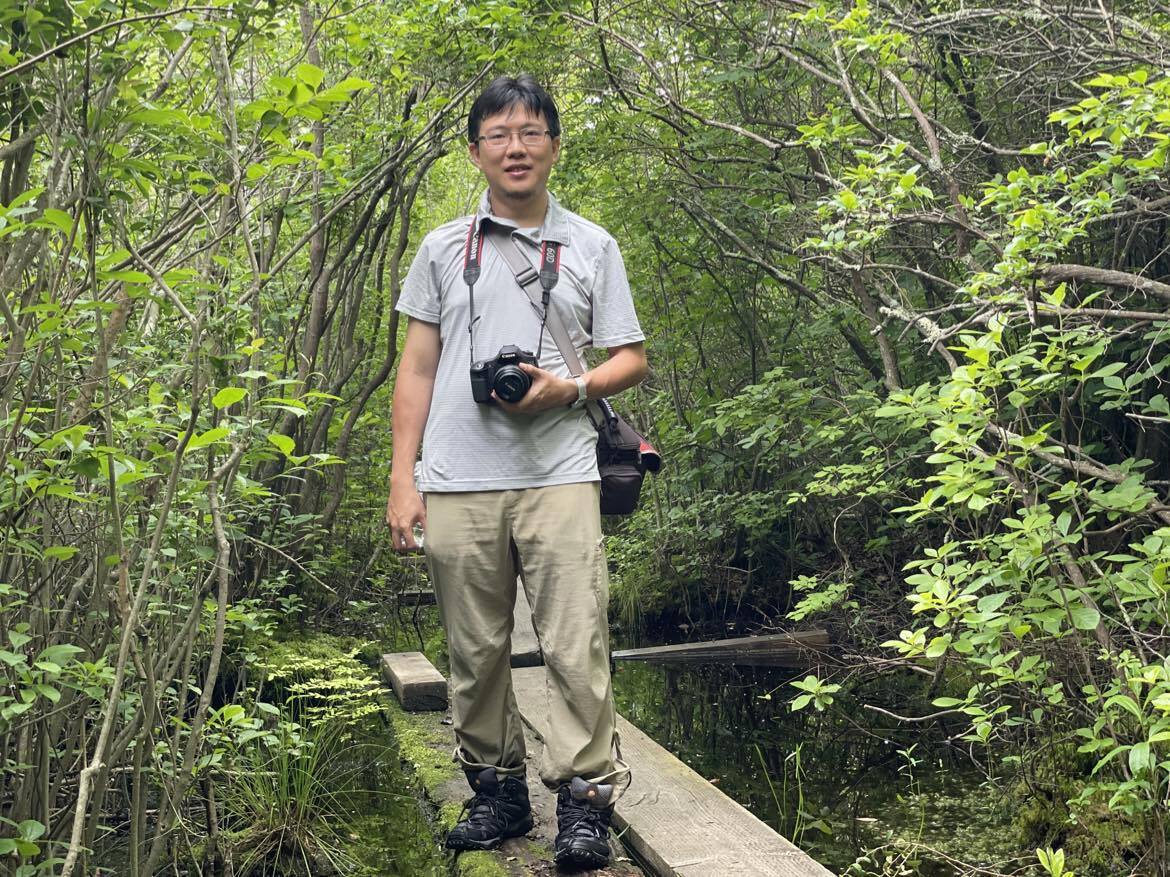歡迎高資棟老師加入中山生科!
Welcome Dr. Tzu-Tong Kao
高資棟老師為臺大生態學與演化生物學研究所碩士、杜克大學生物學系博士、並於中央研究院植物暨微生物研究所擔任博士後研究學者。高老師的專長為海洋微藻與蕨類植物的形態與演化。藉由結合顯微鏡學、細胞生物學、以及多體學分析等方法,多面向的研究探討植物的解剖構造功能與多樣性的演化。
Dr. Kao obtained his master's degree from the Institute of Ecology and Evolutionary Biology at National Taiwan University, completed his Ph.D. in Biology at Duke University, and conducted postdoctoral research at the Institute of Plant and Microbial Biology at Academia Sinica. He specializes in the morphology and evolution of marine microalgae and ferns. Integrating techniques including microscopy, cell biology, and multi-omics analysis, his research delves into the evolution of plant anatomy, function, and diversity from diverse angles.
(1) 海洋鈣板藻 (coccolithophores) 鈣化的起源與演化
鈣板藻是海洋中豐富度前三高的微藻類群之一,在世界的碳循環中扮演著重要角色。除了貢獻全世界近一成的光合作用之外,鈣板藻還藉由生成碳酸鈣(CaCO3)的外骨骼鈣板,將碳以無機的形式固定。這些鈣板在藻體死亡後可能聚集成團,帶著藻體中的有機碳一起下沉,將碳從表層海水移除,是自然界重要的碳儲存方法之一。
鈣板藻屬於定鞭藻門(Haptophyta),是現今真核生物八個主要分類群之一的定鞭藻超群(supergroup Haptista)的主要成員,在生物學上仍有許多未知。高老師以鈣板藻的模式物種赫氏圓石藻(Gephyrocarpsa huxleyi)為材料,藉由剖析該物種與其他橋石藻(Gephyrocarpsa)的粒線體、葉綠體與細胞核基因體,探討該屬在自然界的生殖模式與演化歷史(Kao et al., 2022)。進一步,高老師利用赫氏圓石藻在生活史中產生鈣板與不產生鈣板的兩個世代為材料,應用最新的基因體定序、光學染色體圖譜、與定相技術,組裝出該物種的單套與雙套基因體,並在此基礎上以多體學(基因體學、轉錄體學、蛋白體學、甲基化體學)分析造成兩個世代形態差異的原因,並進一步探討調控鈣板生成的分子機制。
(1) The origin and evolution of calcification in coccolithophores
Coccolithophores are calcifying microalgae with significant ecological importance and are abundant in global oceans. In addition to contributing approximately 10% of global primary production through photosynthesis, they also fix carbon in an inorganic form by producing calcium carbonate (CaCO3) coccoliths. These coccoliths could aggregate and sink to deeper ocean layers, carrying organic detritus with them, thus serving as a carbon sequestration mechanism in nature.
Phylogenetically, coccolithophores belong to the Haptista, one of the eight eukaryotic supergroups, where many aspects of their biology remain unknown. Through the analysis and comparison of the nuclear,mitochondrial, and plastidial genomes of Gephyrocarpsa species, Dr. Kao delved into their complex evolutionary histories and gained insights into their reproductive modes in natural populations (Kao et al., 2022). Furthermore, by leveraging the diploid-haploid variation in coccolith production (only the diploid is calcifying) in the model species G. huxleyi, Dr. Kao employed third-generation high-throughput sequencing, chromosome optical mapping, and genome phase techniques to assemble the haploid and diploid reference-level genome of this species. Building upon this foundation, he employs multi-omics analyses (genomics, transcriptomics, proteomics, and methylomics) to explore the regulatory mechanisms underlying the differentiations between the two life-cycle phases and enhance our understanding of the molecular basis of their coccolith production.

圖一、赫氏圓石藻雙倍體 (圖 a,b) 與單倍體 (圖 c,d) 的掃描式與穿透式電子顯微鏡影像。(a) 雙倍體具有碳酸鈣板組成的外骨骼;(b) 該外骨骼是先在高基氏體衍伸的特化胞器鈣板藻囊泡 (coccolith vesicle,在圖中以 Cv 表示) 中形成,再藉由胞吐釋放到細胞表面。(c) 單倍體則不產生鈣板而具有鞭毛;(d) 細胞內亦無鈣板藻囊泡的分化。
Figure 1. Scanning Electron Microscope (SEM) and Transmission Electron Microscope (TEM) images of the diploid and haploid stages of Gephyrocarpsa huxleyi. (a) The diploid cell exhibit an exoskeleton composed of coccoliths (CaCO3 scales). (b) These coccoliths are synthesized within specialized Golgi-derived organelles, called coccolith vesicles, before being released to the cell surface via exocytosis. (c) The haploid stage is bi-flagellate but does not produce coccoliths. (d) Furthermore, there is no differentiation of coccolith vesicles within the cell.
(2) 碎米蕨 (cheilanthoids) 對乾旱環境的適應與演化
在許多蕨類選擇在陰暗潮濕的環境中生活的同時,也有部分的蕨類選擇在高光與乾燥的環境中生活。鳳尾蕨科(Pteridaceae)的碎米蕨支是其中的佼佼者,它們起源於沙漠並分化出 20 多個屬與近 500 物種,並且藉由對乾旱環境的適應,散播回到了潮濕但有季節性乾旱的季風亞 洲。
面對季節性乾旱的挑戰,碎米蕨支的物種多次演化出各種耐受或逃避乾旱的策略,例如生成減少水分散失的構造、在乾季落葉,或者產生能夠忍受脫水的葉片,因而能在雨季復活。高老師對該群植物的研究涵蓋它們的演化歷史(Kao et al., 2019)、在沙漠中的種化機制(Kao et al., 2020),同時深入探討耐旱相關的形態構造與功能,以及這些構造策略對於它們巨觀演化的影響。
(2) Adaptation and evolution of cheilanthoid ferns in xeric habitats
Not all ferns live in shaded and moist environments. Cheilanthoids, an ecologically unique group of ferns comprising over 20 genera and approximately 500 species, have adapted to and diversified within high-light and xeric habitats, primarily in deserts. Furthermore, a derived lineage of the group has migrated back to seasonally drought regions in monsoon Asia.
Adapting to xeric or seasonally drought habitats, cheilanthoids have developed various strategies, including drought tolerance (utilizing specialized structures to reduce water loss), drought deciduousness,and desiccation tolerance (resurrective ferns!). Dr. Kao's research encompasses the study of their evolutionary history and droughtrelated morphological structures and functions (Kao et al., 2019), modes of reproduction and speciation in deserts (Kao et al., 2020), as well as the analysis of the contributions of different drought adaptation strategies to their macroevolution.

圖二、美洲粉背蕨(Notholaenids)粉背的結構、多樣性和功能。(a)美洲粉背蕨的葉片橫切面。背粉(farina)是由下表面的腺毛分泌出的亮色疏水性類黃酮所構成。(b) 背粉的功能。背粉覆蓋氣孔所在的下表皮,具有遲滯氣體交換減少蒸散的功能。同時,其具有吸收紫外光與反 射紅外光的特性,可能保護脫水的葉片保存復活的潛力。最後,有些背粉可以抵抗掠食者或抑制競爭者的生長。(c) 不同物種具有不同顏色、結構和化學組成的背粉,是物種分類的重要依據,同時也可能通過抑它作用(allelopathy)參與物種的種化。
Figure 2. Structure, diversity, and functions of "farina" in Notholaenids ferns. (a) Cross-section of a leaf showing farina, composed of brightly colored lipophilic flavonoids, is secreted by glandular hairs on the lower surface. (b) Functions of farina: It covers the lower leaf surface where stomata are located, reducing water loss from transpiration. Additionally, it absorbs UV light and reflects infrared, protecting dehydrated leaves from damage for potential resurrection. Moreover, it defends against predators or inhibits competitor growth. (c) Farina exhibits variation in color, structure, and chemical composition among different species, potentially influencing speciation through allelopathic effects.

高老師 2023 年夏天在參加羅德島的美國藻類學年會 (PSA 2023) 前夕,在 Framingham State University 的吳正江 (Cheng-Chiang Wu) 老師引領下前往鄰近麻州的 Ponkapoag Pond Trail 訪查當地的濕地生物多樣性與食蟲植物生態。
Before attending the Phycological Society of America Conference (PSA 2023) in Rhode Island during the summer of 2023, Dr. Kao, hosted by Professor Cheng-Chiang Wu from Framingham State University, visited Ponkapoag Pond Trail in Massachusetts to explore the wetland biodiversity and carnivorous plant ecology.
